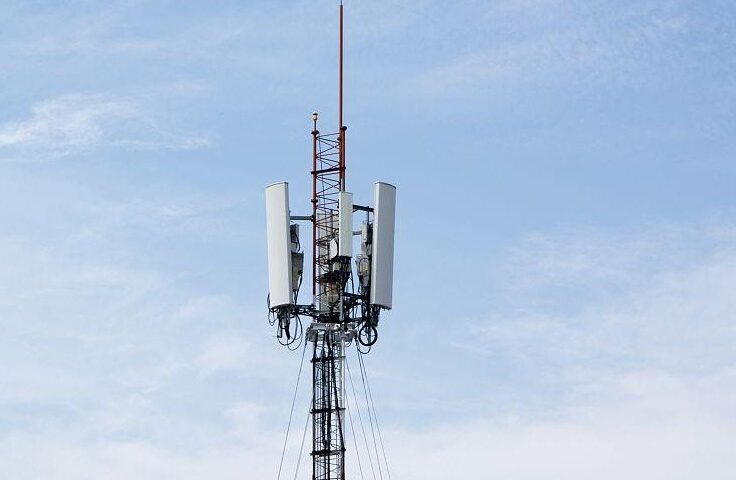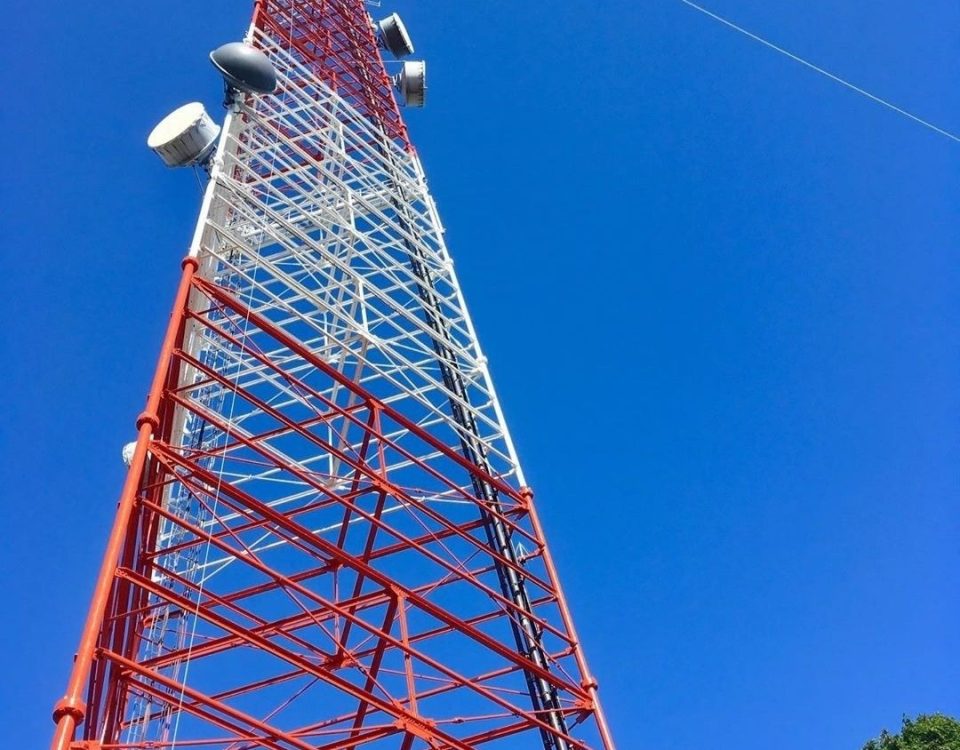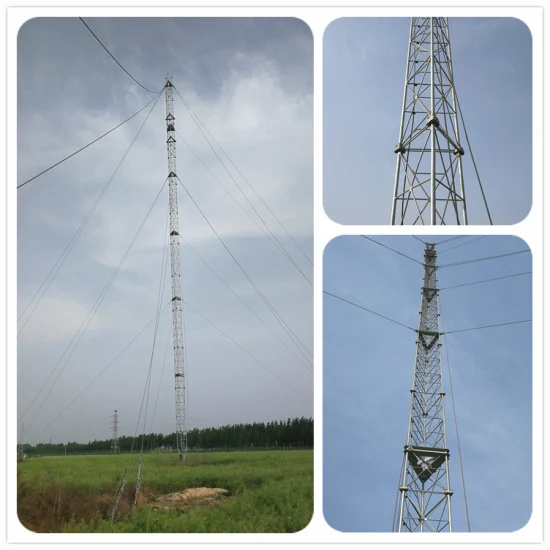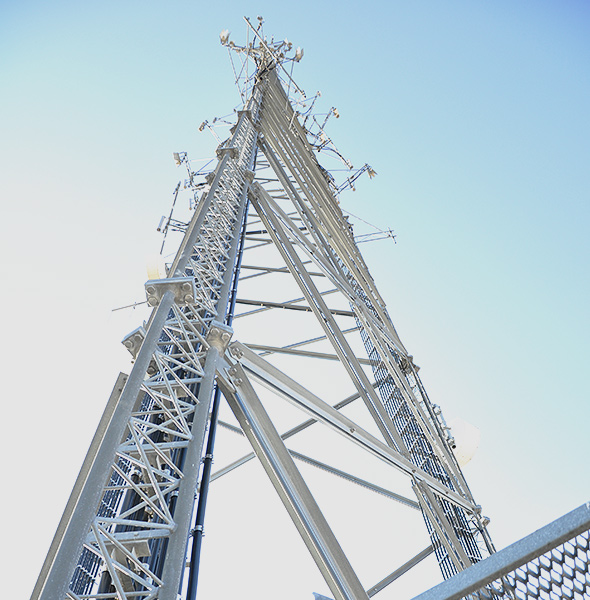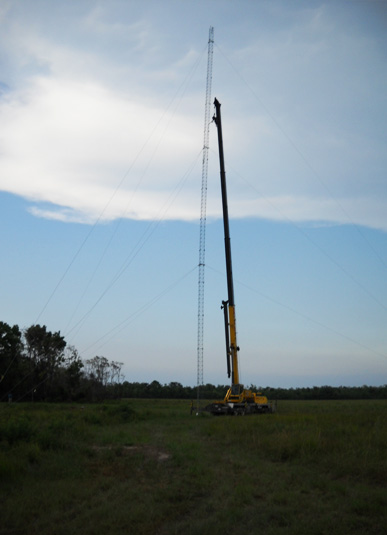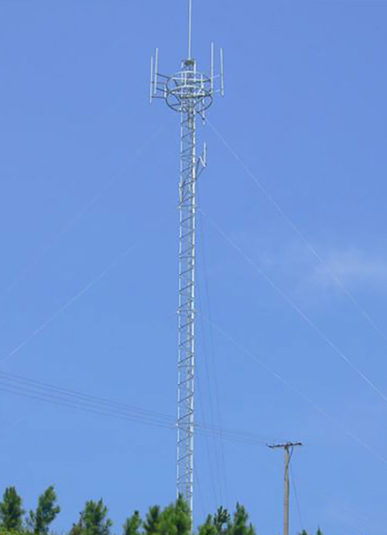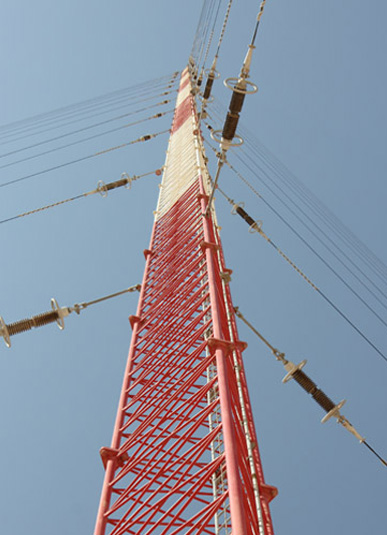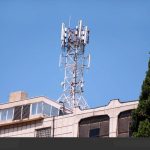
Steel Rooftop Antenna GSM Tower
May 31, 2025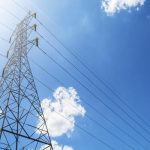
Technical Conditions for Manufacturing Transmission Line Tower
June 27, 2025Guyed Wire Telescopic Antenna Carbon Steel Towers
Scientific Analysis of Guyed Wire Telescopic Antenna Carbon Steel Towers
1. Structural Design and Material Properties of Guyed Wire Telescopic Carbon Steel Towers
Guyed wire telescopic antenna towers constructed from carbon steel are pivotal in telecommunications, particularly for applications requiring rapid deployment and height adjustability, such as GSM networks, amateur radio, and meteorological monitoring. Carbon steel, typically grades like Q235 or Q345, is selected for its high yield strength (235–345 MPa), excellent toughness, and cost-effectiveness compared to alternatives like aluminum or composites. These towers are designed as telescopic systems, where concentric tubular sections slide within one another, allowing for adjustable heights ranging from 5 to 50 meters. The telescopic mechanism is facilitated by a combination of manual crank systems, pulleys, or electric winches, with safety features like locking pins to prevent unwanted retraction.
The structural design of these towers relies on a lattice or tubular configuration, with the guy wires providing critical lateral stability. The guy wires, typically high-strength galvanized steel (e.g., Extra High Strength [EHS] strands with breaking strengths of 3,990–6,000 lbs), are anchored to the ground or a structure at angles of 45–60 degrees, forming a tripod or quad arrangement. This configuration minimizes shear stresses, allowing the tower to withstand wind speeds up to 70–90 mph (112–145 kph). Hot-dip galvanization, with a coating thickness of 80–100 µm, ensures corrosion resistance, extending service life to 20–30 years in harsh urban or coastal environments. Finite element analysis (FEA) using tools like STAAD.Pro models the tower’s response to combined loads, including self-weight (500–2,000 kg), antenna payload (50–300 lbs), and environmental forces. The design must comply with standards like EIA/TIA-222 or EN 1993-3-1, ensuring safety factors of 1.5–2.0 for ultimate loads.
|
Parameter
|
Description
|
Typical Values
|
|---|---|---|
|
Material
|
Carbon steel
|
Q235, Q345
|
|
Yield Strength
|
Minimum stress before deformation
|
235–345 MPa
|
|
Tower Height
|
Adjustable range
|
5–50 m
|
|
Guy Wire Strength
|
Breaking strength
|
3,990–6,000 lbs
|
|
Corrosion Protection
|
Hot-dip galvanization
|
80–100 µm
|
2. Load Analysis and Environmental Considerations
The primary environmental loads affecting guyed wire telescopic carbon steel towers include wind, ice, and seismic forces. Wind loads, calculated per EIA/TIA-222, are critical due to the tower’s height and antenna surface area (5–25 sq. ft). For a 20-meter tower with a 10 sq. ft antenna, wind speeds of 70 mph generate base shear forces of 15–25 kN and overturning moments of 80–150 kNm. Guy wires distribute these forces to anchors, reducing the risk of buckling. Ice accumulation, particularly in cold climates, increases the effective surface area, amplifying wind loads by 10–20%. Standards like EN 1993-3-1 recommend reducing wind load factors (0.75–0.85) when ice is present to account for combined effects.
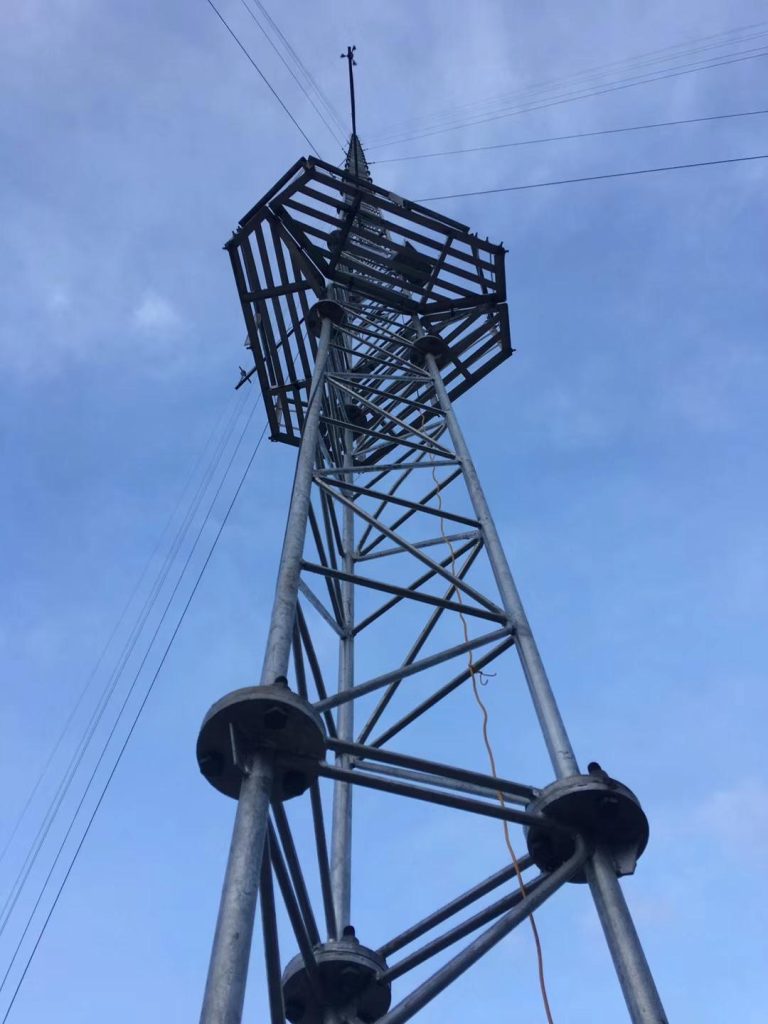
Seismic loads are analyzed using time history or response spectrum methods, with natural frequencies typically ranging from 1–5 Hz for telescopic towers. A study on a 30-meter guyed tower showed that viscous dampers reduced peak displacements by 25–30%, enhancing stability in earthquake-prone regions. The foundation, often a concrete base or screw anchors, must resist uplift forces from guy wires (5–15 kN per anchor) and compressive loads from the tower’s self-weight. Soil conditions, such as cohesive or granular soils, influence anchor design, with pull-out capacities of 10–20 kN required for typical installations.
|
Load Type
|
Typical Value
|
Impact on Tower
|
|---|---|---|
|
Wind Load
|
70–90 mph
|
Shear: 15–25 kN, Moment: 80–150 kNm
|
|
Ice Load
|
5–10 mm thickness
|
Increases leg forces by 10–20%
|
|
Seismic Load
|
0.1–0.3g acceleration
|
Displacement: 10–40 mm
|
|
Anchor Pull-Out
|
10–20 kN
|
Ensures guy wire stability
|
3. Antenna Arrangement and Electromagnetic Performance
The antenna arrangement on guyed wire telescopic towers significantly impacts both structural and electromagnetic performance. GSM antennas, operating at 790–960 MHz, are typically mounted at the tower’s apex to maximize coverage. The number and configuration of antennas (e.g., single-layer vs. multi-layer) affect wind loading and signal quality. A single-layer arrangement with four antennas reduces the drag coefficient to 1.2–1.5, compared to 1.8–2.0 for multi-layered setups, lowering overturning moments by 40–50%. Antennas with high gain (15–18 dBi) and 60–90-degree beamwidths are optimized for urban GSM coverage, achieving ranges of 2–5 km.
Electromagnetic interference from conductive guy wires is a concern, as they can distort radiation patterns if their lengths are near quarter-wavelength multiples of the transmission frequency. To mitigate this, guy wires are segmented with strain insulators (e.g., porcelain “Johnny ball” insulators) to create non-resonant sections. Alternatively, non-conductive materials like Kevlar or fiberglass (Phillystran) are used, offering tensile strengths comparable to steel (up to 6,000 lbs) without affecting signal propagation. Measurements from urban GSM sites show power densities levels of 10⁻⁵–10⁻² W/m², well below ICNIRP limits of 4.5 W/m² at 900 MHz, ensuring public safety.
|
Configuration
|
Drag Coefficient
|
Overturning Moment (kNm)
|
SNR Improvement (dB)
|
|---|---|---|---|
|
Single Layer, 4 Antennas
|
1.2–1.5
|
80–120
|
5–8
|
|
Multi-Layer, 4 Antennas
|
1.8–2.0
|
150–200
|
3–5
|
|
Non-Conductive Guys
|
1.2–1.5
|
80–120
|
6–10
|
4. Comparison with Other Tower Types
Guyed wire telescopic carbon steel towers differ from self-supporting towers, monopoles, and rooftop lattice towers in design and application. Self-supporting towers (15–150 m) require larger foundations and are less adaptable to rapid deployment, with installation costs of $30,000–100,000 compared to $10,000–30,000 for telescopic guyed towers. Monopoles, while aesthetically pleasing, have higher buckling risks (15–20% greater than lattice designs) and are less suitable for heavy payloads. Rooftop lattice towers, limited to 5–20 m, are constrained by building capacity but offer easier maintenance access.
Telescopic guyed towers excel in flexibility, with adjustable heights and lightweight designs (500–2,000 kg). Their reliance on guy wires reduces material costs but increases land requirements for anchors, making them less ideal for urban rooftops compared to lattice towers. Electromagnetically, guyed towers require careful design to avoid signal interference, unlike self-supporting towers, which have fewer conductive elements. The table below compares key parameters.
|
Tower Type
|
Height Range (m)
|
Base Shear (kN)
|
Installation Cost (USD)
|
Maintenance Complexity
|
|---|---|---|---|---|
|
Guyed Telescopic
|
5–50
|
15–25
|
10,000–30,000
|
Moderate
|
|
Self-Supporting
|
15–150
|
15–40
|
30,000–100,000
|
Moderate
|
|
10–50
|
12–25
|
15,000–40,000
|
Low
|
|
|
Rooftop Lattice
|
5–20
|
10–20
|
10,000–30,000
|
Low
|
5. Design Optimization and Technological Advances
Design optimization of guyed wire telescopic carbon steel towers leverages advanced computational tools like ASMTower, which performs P-delta analysis to account for second-order effects under large deformations. For a 30-meter tower, deflections are limited to 10–20 mm to ensure antenna alignment. Finite element models incorporating 3D beam and truss elements improve stress prediction accuracy by 10–15% compared to simpler truss models. Nature-inspired optimization algorithms, combined with surrogate modeling, reduce computational costs by 30–40% while optimizing guy wire placement and tension.
The transition to 5G has increased antenna payloads, raising wind loads by 20–30%. Optimizing antenna arrangements (e.g., single-layer configurations) mitigates this, maintaining structural safety. Synthetic guy wires, such as Kevlar or fiberglass, are gaining popularity due to their lightweight nature (50–60% lighter than steel) and non-conductive properties, reducing installation complexity and electromagnetic interference. Smart towers with real-time load sensors enhance maintenance efficiency by 15–20%, detecting stress anomalies early.
|
Optimization Technique
|
Benefit
|
Reduction in Cost/Time
|
|---|---|---|
|
P-Delta Analysis
|
Reduces deflection errors
|
10–15%
|
|
3D Beam FEM
|
Improves stress prediction
|
10–20%
|
|
Synthetic Guy Wires
|
Reduces weight and interference
|
20–30%
|
|
Sensor Integration
|
Enhances maintenance
|
15–20%
|
6. Safety and Regulatory Compliance
Safety considerations for guyed wire telescopic towers include structural stability, RF exposure, and maintenance protocols. EIA/TIA-222 mandates safety factors of 1.5–2.0 for ultimate loads, while ICNIRP limits RF exposure to 4.5 W/m² at 900 MHz, with typical measurements showing compliance at 10⁻⁵–10⁻² W/m². Guy wire tensioning, using turnbuckles or come-alongs, must be precise to avoid over-tightening, which can increase compressive stresses by 10–15%. Regular inspections for corrosion, insulator integrity, and anchor stability are critical, particularly for carbon steel components exposed to coastal environments.
Regulatory compliance includes adherence to local zoning laws, which may limit tower heights to 70 ft (21 m) without permits, as seen in some urban areas. Aesthetic concerns are addressed through camouflaged designs, such as tree-like monopoles, though these increase costs by 10–20%. The table below summarizes safety metrics.
|
Safety Aspect
|
Requirement
|
Typical Compliance
|
|---|---|---|
|
Structural Safety Factor
|
1.5–2.0
|
Met with Q345 steel
|
|
RF Exposure Limit
|
4.5 W/m²
|
10⁻⁵–10⁻² W/m²
|
|
Deflection Limit
|
10–20 mm
|
Achieved with P-delta analysis
|
|
Guy Wire Tension
|
500–1,500 lbs
|
Adjusted via turnbuckles
|
7. Future Trends and Challenges
The future of guyed wire telescopic carbon steel towers lies in integrating advanced materials and technologies. Composite materials, such as carbon fiber-reinforced polymers, could reduce tower weight by 20–30%, but their cost (2–3 times that of steel) limits adoption. Smart sensors for real-time monitoring of guy wire tension and structural health are emerging, reducing maintenance costs by 15–20%. The shift to 5G and beyond requires higher antenna densities, increasing structural demands and necessitating retrofitting of existing towers, which can raise costs by 10–20%.
Challenges include managing land requirements for guy wire anchors in urban settings and mitigating electromagnetic interference from conductive components. Innovations in non-conductive guy wires and modular designs aim to address these issues, enhancing deployment flexibility. The table below outlines future trends.
|
Trend
|
Impact
|
Challenge
|
|---|---|---|
|
Composite Materials
|
Reduces weight by 20–30%
|
High cost
|
|
Smart Sensors
|
Improves maintenance efficiency
|
Integration complexity
|
|
Modular Designs
|
Enhances deployment flexibility
|
Higher initial costs
|
|
5G Upgrades
|
Improves data rates
|
Increased structural loads
|
Related posts
December 2, 2018

